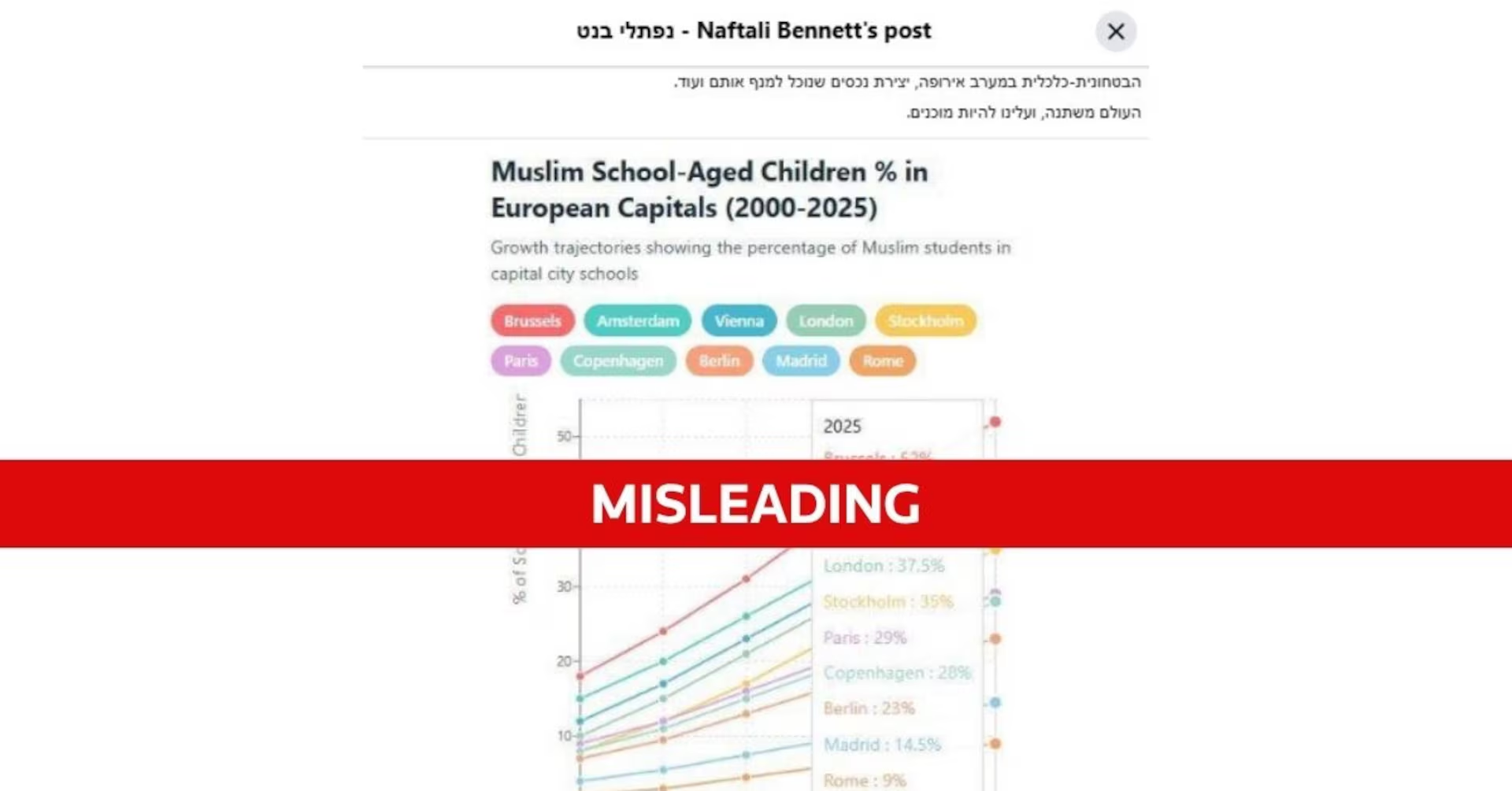Listen to the article
A viral chart claiming to show high percentages of Muslim school-aged children in major European capitals contains exaggerated or fabricated data, according to a Reuters investigation. The chart, which has been widely shared on social media platforms, fails to match official statistics and misrepresents its supposed sources.
The earliest identifiable post of the chart appeared on August 16 from Shirion Collective, an organization previously condemned by the Florida chapter of the Council on American-Islamic Relations for harassing pro-Palestinian activists. The graphic gained significant traction when former Israeli Prime Minister Naftali Bennett shared it on his social media accounts with the caption “Europe is converting to Islam.”
Bennett later provided a list of sources for the chart, but Reuters found these sources either didn’t contain the claimed data or directly contradicted the figures presented in the viral graphic. The chart purports to show current percentages of Muslim schoolchildren in ten European capitals along with projections for 2025, suggesting dramatic demographic shifts.
Among the most glaring discrepancies was a citation of “David Drai” as a source. When contacted by Reuters, David Drai, chairman and co-founder of Israeli AI-driven analytics firm Anodot, confirmed he had “nothing to do with the chart” and had “never seen it before.”
Tech billionaire Elon Musk also amplified the chart, directing X users to an analysis by his AI chatbot Grok, which itself acknowledged the data “shows potential exaggeration.”
For Brussels, which topped the chart with a claimed 52% Muslim student population, Belgium’s education authorities confirmed they don’t collect official data on schoolchildren’s religion. The documents cited by Bennett as sources examined poverty levels but contained no religious demographic information.
In London, where the chart claimed 37% of schoolchildren are Muslim, the Office for National Statistics told Reuters the actual figure is approximately 24.6%, based on voluntary census responses. The Muslim Council of Britain estimated similar figures between 22.7% and 23.0%.
Similarly inflated figures appeared for Stockholm (35% claimed vs. 22-30% estimated by statistical methods), Paris (29% claimed without official data to support it), Copenhagen (28% claimed vs. 12% from official sources), Berlin (23% claimed vs. 3.78% enrolled in Islamic religious education), Madrid (14.5% claimed vs. 7.2% from the same source the chart purportedly used), and Rome (9% claimed, though Italy doesn’t collect such data).
Only Vienna’s figure matched official statistics, with 41% of students in state elementary and middle schools being Muslim. However, even this figure is misleading as it excludes private and federal schools, which would lower the overall percentage.
Many European countries explicitly avoid collecting data on citizens’ religious affiliations due to legal restrictions, privacy concerns, and historical sensitivities. Countries like France have strict secularism principles that prohibit gathering such information, while others face constraints under the European Union’s General Data Protection Regulation.
Some researchers attempt to estimate religious demographics using country-of-origin data for students with immigrant backgrounds, but these methods have significant limitations and can’t produce the precise figures claimed in the chart.
Neither the Shirion Collective nor Bennett responded to multiple requests for comment from Reuters regarding the methodology used to create the chart or the source of their data.
The misleading demographic claims come amid heightened tensions around immigration and religious integration across Europe, with far-right political movements gaining strength in several countries. Demographic misinformation often fuels divisive narratives about cultural replacement or religious conversion, despite lacking factual basis in official statistics.
Fact Checker
Verify the accuracy of this article using The Disinformation Commission analysis and real-time sources.




5 Comments
The article raises valid concerns about the reliability and motives behind this viral chart. It’s a good reminder to always scrutinize data, especially on controversial issues, and to rely on credible, impartial sources. Fact-checking is crucial in the digital age.
Interesting fact check on that misleading chart about Muslim students in Europe. It’s important to rely on official statistics and credible sources rather than unverified social media claims. I appreciate the effort to correct the misinformation.
This chart seems to be another example of how false narratives can spread quickly online, even when the data is fabricated or exaggerated. It’s good to see a thorough debunking using Reuters’ investigation. Facts and transparency are crucial.
This fact check highlights the need for greater media literacy and critical thinking when it comes to online content. It’s troubling to see misleading information being amplified, even by public figures. Maintaining objectivity and truth is paramount.
While demographic shifts are an important topic, this chart appears to distort the reality. I’m glad the authorities are actively working to correct such misinformation. Responsible reporting and fact-checking are essential in these sensitive discussions.